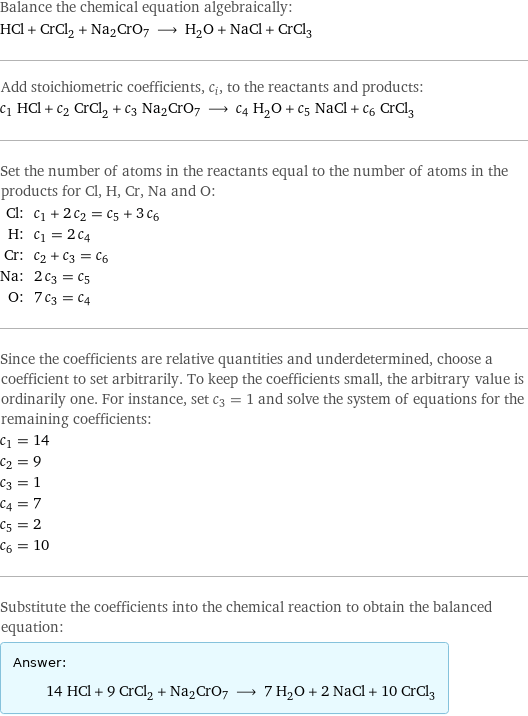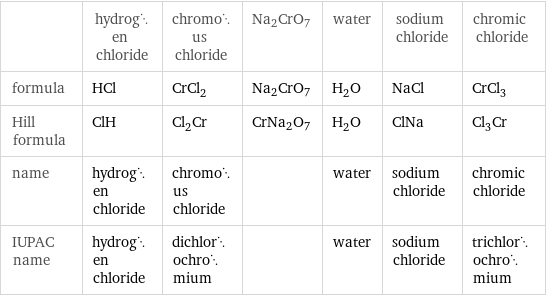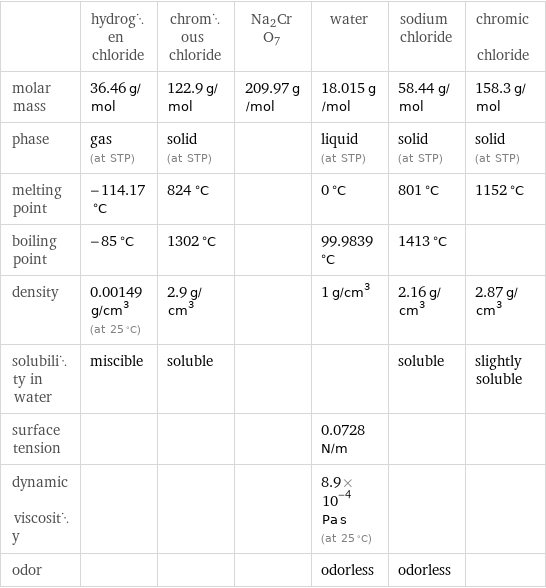Input interpretation

HCl hydrogen chloride + CrCl_2 chromous chloride + Na2CrO7 ⟶ H_2O water + NaCl sodium chloride + CrCl_3 chromic chloride
Balanced equation

Balance the chemical equation algebraically: HCl + CrCl_2 + Na2CrO7 ⟶ H_2O + NaCl + CrCl_3 Add stoichiometric coefficients, c_i, to the reactants and products: c_1 HCl + c_2 CrCl_2 + c_3 Na2CrO7 ⟶ c_4 H_2O + c_5 NaCl + c_6 CrCl_3 Set the number of atoms in the reactants equal to the number of atoms in the products for Cl, H, Cr, Na and O: Cl: | c_1 + 2 c_2 = c_5 + 3 c_6 H: | c_1 = 2 c_4 Cr: | c_2 + c_3 = c_6 Na: | 2 c_3 = c_5 O: | 7 c_3 = c_4 Since the coefficients are relative quantities and underdetermined, choose a coefficient to set arbitrarily. To keep the coefficients small, the arbitrary value is ordinarily one. For instance, set c_3 = 1 and solve the system of equations for the remaining coefficients: c_1 = 14 c_2 = 9 c_3 = 1 c_4 = 7 c_5 = 2 c_6 = 10 Substitute the coefficients into the chemical reaction to obtain the balanced equation: Answer: | | 14 HCl + 9 CrCl_2 + Na2CrO7 ⟶ 7 H_2O + 2 NaCl + 10 CrCl_3
Structures

+ + Na2CrO7 ⟶ + +
Names

hydrogen chloride + chromous chloride + Na2CrO7 ⟶ water + sodium chloride + chromic chloride
Equilibrium constant
![Construct the equilibrium constant, K, expression for: HCl + CrCl_2 + Na2CrO7 ⟶ H_2O + NaCl + CrCl_3 Plan: • Balance the chemical equation. • Determine the stoichiometric numbers. • Assemble the activity expression for each chemical species. • Use the activity expressions to build the equilibrium constant expression. Write the balanced chemical equation: 14 HCl + 9 CrCl_2 + Na2CrO7 ⟶ 7 H_2O + 2 NaCl + 10 CrCl_3 Assign stoichiometric numbers, ν_i, using the stoichiometric coefficients, c_i, from the balanced chemical equation in the following manner: ν_i = -c_i for reactants and ν_i = c_i for products: chemical species | c_i | ν_i HCl | 14 | -14 CrCl_2 | 9 | -9 Na2CrO7 | 1 | -1 H_2O | 7 | 7 NaCl | 2 | 2 CrCl_3 | 10 | 10 Assemble the activity expressions accounting for the state of matter and ν_i: chemical species | c_i | ν_i | activity expression HCl | 14 | -14 | ([HCl])^(-14) CrCl_2 | 9 | -9 | ([CrCl2])^(-9) Na2CrO7 | 1 | -1 | ([Na2CrO7])^(-1) H_2O | 7 | 7 | ([H2O])^7 NaCl | 2 | 2 | ([NaCl])^2 CrCl_3 | 10 | 10 | ([CrCl3])^10 The equilibrium constant symbol in the concentration basis is: K_c Mulitply the activity expressions to arrive at the K_c expression: Answer: | | K_c = ([HCl])^(-14) ([CrCl2])^(-9) ([Na2CrO7])^(-1) ([H2O])^7 ([NaCl])^2 ([CrCl3])^10 = (([H2O])^7 ([NaCl])^2 ([CrCl3])^10)/(([HCl])^14 ([CrCl2])^9 [Na2CrO7])](../image_source/38eb8c570ecf8484746a12a0090a6ca3.png)
Construct the equilibrium constant, K, expression for: HCl + CrCl_2 + Na2CrO7 ⟶ H_2O + NaCl + CrCl_3 Plan: • Balance the chemical equation. • Determine the stoichiometric numbers. • Assemble the activity expression for each chemical species. • Use the activity expressions to build the equilibrium constant expression. Write the balanced chemical equation: 14 HCl + 9 CrCl_2 + Na2CrO7 ⟶ 7 H_2O + 2 NaCl + 10 CrCl_3 Assign stoichiometric numbers, ν_i, using the stoichiometric coefficients, c_i, from the balanced chemical equation in the following manner: ν_i = -c_i for reactants and ν_i = c_i for products: chemical species | c_i | ν_i HCl | 14 | -14 CrCl_2 | 9 | -9 Na2CrO7 | 1 | -1 H_2O | 7 | 7 NaCl | 2 | 2 CrCl_3 | 10 | 10 Assemble the activity expressions accounting for the state of matter and ν_i: chemical species | c_i | ν_i | activity expression HCl | 14 | -14 | ([HCl])^(-14) CrCl_2 | 9 | -9 | ([CrCl2])^(-9) Na2CrO7 | 1 | -1 | ([Na2CrO7])^(-1) H_2O | 7 | 7 | ([H2O])^7 NaCl | 2 | 2 | ([NaCl])^2 CrCl_3 | 10 | 10 | ([CrCl3])^10 The equilibrium constant symbol in the concentration basis is: K_c Mulitply the activity expressions to arrive at the K_c expression: Answer: | | K_c = ([HCl])^(-14) ([CrCl2])^(-9) ([Na2CrO7])^(-1) ([H2O])^7 ([NaCl])^2 ([CrCl3])^10 = (([H2O])^7 ([NaCl])^2 ([CrCl3])^10)/(([HCl])^14 ([CrCl2])^9 [Na2CrO7])
Rate of reaction
![Construct the rate of reaction expression for: HCl + CrCl_2 + Na2CrO7 ⟶ H_2O + NaCl + CrCl_3 Plan: • Balance the chemical equation. • Determine the stoichiometric numbers. • Assemble the rate term for each chemical species. • Write the rate of reaction expression. Write the balanced chemical equation: 14 HCl + 9 CrCl_2 + Na2CrO7 ⟶ 7 H_2O + 2 NaCl + 10 CrCl_3 Assign stoichiometric numbers, ν_i, using the stoichiometric coefficients, c_i, from the balanced chemical equation in the following manner: ν_i = -c_i for reactants and ν_i = c_i for products: chemical species | c_i | ν_i HCl | 14 | -14 CrCl_2 | 9 | -9 Na2CrO7 | 1 | -1 H_2O | 7 | 7 NaCl | 2 | 2 CrCl_3 | 10 | 10 The rate term for each chemical species, B_i, is 1/ν_i(Δ[B_i])/(Δt) where [B_i] is the amount concentration and t is time: chemical species | c_i | ν_i | rate term HCl | 14 | -14 | -1/14 (Δ[HCl])/(Δt) CrCl_2 | 9 | -9 | -1/9 (Δ[CrCl2])/(Δt) Na2CrO7 | 1 | -1 | -(Δ[Na2CrO7])/(Δt) H_2O | 7 | 7 | 1/7 (Δ[H2O])/(Δt) NaCl | 2 | 2 | 1/2 (Δ[NaCl])/(Δt) CrCl_3 | 10 | 10 | 1/10 (Δ[CrCl3])/(Δt) (for infinitesimal rate of change, replace Δ with d) Set the rate terms equal to each other to arrive at the rate expression: Answer: | | rate = -1/14 (Δ[HCl])/(Δt) = -1/9 (Δ[CrCl2])/(Δt) = -(Δ[Na2CrO7])/(Δt) = 1/7 (Δ[H2O])/(Δt) = 1/2 (Δ[NaCl])/(Δt) = 1/10 (Δ[CrCl3])/(Δt) (assuming constant volume and no accumulation of intermediates or side products)](../image_source/ee68c85ff27da0c5e7588b2b4e343436.png)
Construct the rate of reaction expression for: HCl + CrCl_2 + Na2CrO7 ⟶ H_2O + NaCl + CrCl_3 Plan: • Balance the chemical equation. • Determine the stoichiometric numbers. • Assemble the rate term for each chemical species. • Write the rate of reaction expression. Write the balanced chemical equation: 14 HCl + 9 CrCl_2 + Na2CrO7 ⟶ 7 H_2O + 2 NaCl + 10 CrCl_3 Assign stoichiometric numbers, ν_i, using the stoichiometric coefficients, c_i, from the balanced chemical equation in the following manner: ν_i = -c_i for reactants and ν_i = c_i for products: chemical species | c_i | ν_i HCl | 14 | -14 CrCl_2 | 9 | -9 Na2CrO7 | 1 | -1 H_2O | 7 | 7 NaCl | 2 | 2 CrCl_3 | 10 | 10 The rate term for each chemical species, B_i, is 1/ν_i(Δ[B_i])/(Δt) where [B_i] is the amount concentration and t is time: chemical species | c_i | ν_i | rate term HCl | 14 | -14 | -1/14 (Δ[HCl])/(Δt) CrCl_2 | 9 | -9 | -1/9 (Δ[CrCl2])/(Δt) Na2CrO7 | 1 | -1 | -(Δ[Na2CrO7])/(Δt) H_2O | 7 | 7 | 1/7 (Δ[H2O])/(Δt) NaCl | 2 | 2 | 1/2 (Δ[NaCl])/(Δt) CrCl_3 | 10 | 10 | 1/10 (Δ[CrCl3])/(Δt) (for infinitesimal rate of change, replace Δ with d) Set the rate terms equal to each other to arrive at the rate expression: Answer: | | rate = -1/14 (Δ[HCl])/(Δt) = -1/9 (Δ[CrCl2])/(Δt) = -(Δ[Na2CrO7])/(Δt) = 1/7 (Δ[H2O])/(Δt) = 1/2 (Δ[NaCl])/(Δt) = 1/10 (Δ[CrCl3])/(Δt) (assuming constant volume and no accumulation of intermediates or side products)
Chemical names and formulas

| hydrogen chloride | chromous chloride | Na2CrO7 | water | sodium chloride | chromic chloride formula | HCl | CrCl_2 | Na2CrO7 | H_2O | NaCl | CrCl_3 Hill formula | ClH | Cl_2Cr | CrNa2O7 | H_2O | ClNa | Cl_3Cr name | hydrogen chloride | chromous chloride | | water | sodium chloride | chromic chloride IUPAC name | hydrogen chloride | dichlorochromium | | water | sodium chloride | trichlorochromium
Substance properties

| hydrogen chloride | chromous chloride | Na2CrO7 | water | sodium chloride | chromic chloride molar mass | 36.46 g/mol | 122.9 g/mol | 209.97 g/mol | 18.015 g/mol | 58.44 g/mol | 158.3 g/mol phase | gas (at STP) | solid (at STP) | | liquid (at STP) | solid (at STP) | solid (at STP) melting point | -114.17 °C | 824 °C | | 0 °C | 801 °C | 1152 °C boiling point | -85 °C | 1302 °C | | 99.9839 °C | 1413 °C | density | 0.00149 g/cm^3 (at 25 °C) | 2.9 g/cm^3 | | 1 g/cm^3 | 2.16 g/cm^3 | 2.87 g/cm^3 solubility in water | miscible | soluble | | | soluble | slightly soluble surface tension | | | | 0.0728 N/m | | dynamic viscosity | | | | 8.9×10^-4 Pa s (at 25 °C) | | odor | | | | odorless | odorless |
Units
